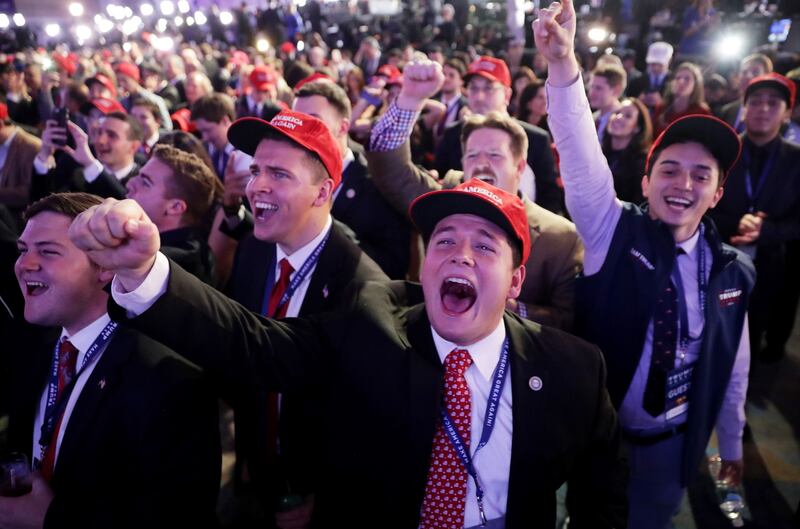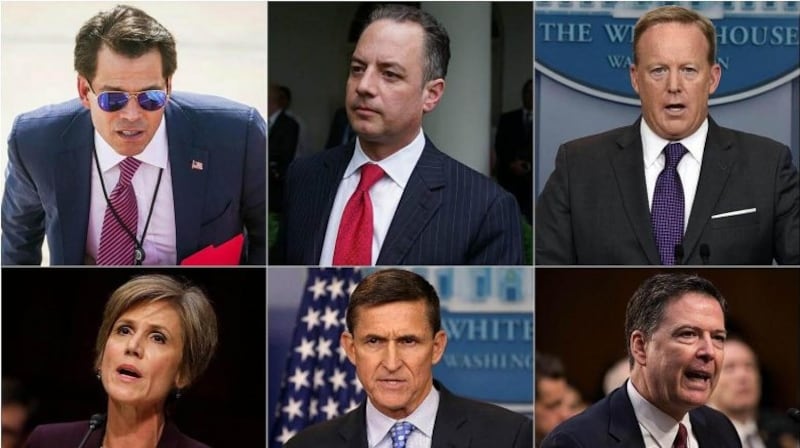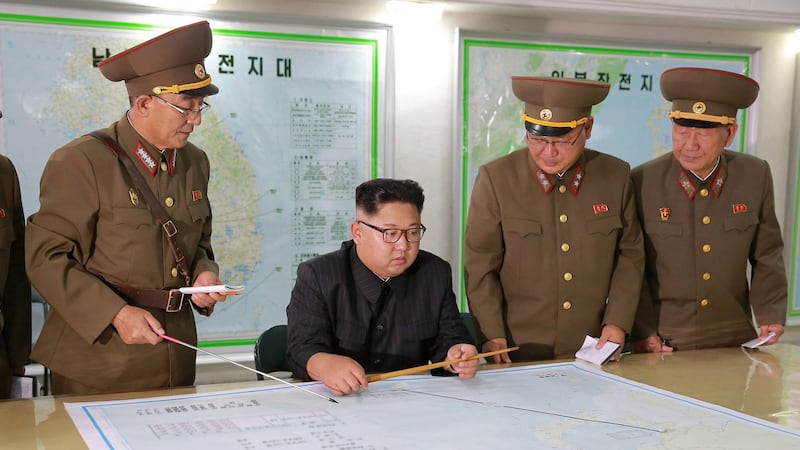It was approaching 3am on the morning of Wednesday, November 9th, and Donald Trump took to the stage at the New York Hilton in midtown Manhattan. Minutes earlier, Hillary Clinton had called the billionaire businessman to concede the US presidential election. Trump, surrounded by his family, began his victory speech.
Across town in the Javits Center, a venue chosen specifically for its glass ceiling, the mood at the Clinton election-night party had darkened as the results rolled in. Shortly after 2am, Clinton's campaign manager John Podesta appeared on stage and told Clinton's supporters there would be no further statement that night. As the assembled crowds began to leave, the nation and the world, looked on in disbelief.
Donald J Trump, a property tycoon and reality television star with no political experience, defied all odds and upended centuries of political convention to clinch the 45th presidency of the United States.
The election was close – a confluence of factors including a better-than-expected turnout of white working-class voters in key states and lower participation of black and Hispanic voters helped to push him over the magic 270 electoral college vote line. But his victory was undisputed.
Trump’s aggressive campaigning style and unlikely emergence as the saviour of the white working-class delivered, as states across the midwest, from Pennsylvania to Ohio to Wisconsin, which had been won by Barack Obama and were once solidly Democrat, fell to Trump.

Flouted all norms
Even at this early stage, many of Trump’s most vociferous critics hoped the man who had flouted all norms of political discourse during the campaign – calling Mexicans rapists and boasting about sexually assaulting women – would temper his behaviour as president. His victory speech even contained a rare note of humility and dignity. “Now it’s time for America to bind the wounds of division. We have to get together,” he said as he declared victory in the early hours of November 9th. “To all Republicans, Democrats and Independents across this nation, I say it is time for us to come together as one united people.”
But any hope the president would make the transition from mercurial candidate to a president for all Americans quickly evaporated.
In the 10 months since his inauguration, Donald Trump has torn up the political rulebook and continued to practise the particular brand of divisive, aggrieved populism that helped propel him to the White House.
Even from the early days of his victory, as he plotted his transition to Washington from the gilded surroundings of Trump Tower, conducting the interview process for the top jobs in the White House like a reality TV show, there were signs that Trump would not abandon his inflammatory rhetoric.
His explosive inauguration speech, in which he invoked a dystopian image of America as a wasteland, with “rusted-out factories scattered like tombstones across the landscape of our nation”, was a sign of things to come.
Within days of his inauguration he signed an executive order outlawing immigration from seven Muslim-majority countries, a move that sparked protests across the country and the world and a flurry of legal challenges.
Three weeks later, he fired national security adviser Michael Flynn, the former general who was pictured sitting next to Putin at a 2015 dinner in Moscow, after it was revealed he had held undisclosed meetings with Russian officials, including Russian ambassador Sergey Kislyak.
The sensational dismissal of the nation's top security chief spawned a wave of questions about Trump's judgment in appointing him to the position in the first place and how much Trump and the administration knew about the meetings, a question that would eventually feed into the special counsel investigation led by Robert Mueller.
By early April, he astonished the international community by ordering airstrikes in Syria in response to a chemical attack, an early example of his impulsive and emotive approach to foreign policy which would manifest itself later in the year when he sparked tensions with North Korea.
A month later, he fired FBI chief James Comey, a move that prompted the appointment of special counsel Robert Mueller to investigate Russian interference in the election and possible collusion between the Trump campaign team and Russia.

Trump’s tweets
As the roller-coaster of his first months in office captivated the world, Trump’s tweets acted as a constant narrative of the presidency, as he used social media to attack his opponents and rant directly at his followers.
From mocking a female TV host for “bleeding badly from a facelift”, to engaging in a public spat with the widow of a slain American solider, to belittling members of his own party, Twitter became the tool by which Trump lashed out at the world.
As Trump's critics looked on in outrage, there was some hope a change in personnel at the White House in late summer would help rein in the president's unorthodox behaviour and incessant tweeting. The departure of chief of staff Reince Priebus, press secretary Sean Spicer and chief strategist Steve Bannon and the installation of former four-star Marine general John Kelly as chief of staff prompted expectations of a new discipline in the West Wing. But the tweeting and unscripted controversies continued as Trump lurched from crisis to crisis in the autumn, from failing to condemn white supremacism in Charlottesville, to sparking tensions with North Korea through inflammatory comments.
As American marks the first-year anniversary of an election that has bitterly divided this country, many are reflecting on the reality of the Trump presidency. Some critics have been quick to argue that, for all his bluster and caustic rhetoric, Trump has achieved little. Despite Republicans controlling all levers of power in Washington, the Republican Party has little to show in terms of legislative achievements. The plan to repeal and replace Obamacare lies in ruins as the Republican party failed to resolve internal divisions about how to repeal a nation’s healthcare system which, despite its unquestionable failings, has become more popular with Americans.
Similarly, the party’s other big policy objective – tax reform – is facing significant obstacles, as Republicans squabble over which tax cuts to implement and how to compensate for more than $1.5 trillion in lost taxes over the next decade.
But dismissing Trump as a blustering ideologue, full of broken promises, would be to underestimate the impact of his presidency. Behind the drama and intrigue of the White House, the Trump administration is pushing through changes that could have implications for decades to come.
While his policy failures are there to see, Trump has been stealthily undoing the legacy of his predecessor Barack Obama by pushing his presidential powers to their limits.
On immigration and border security, he has followed through on his promise to stem Muslim immigration into the US, unveiling several versions of his travel ban. Though the ban is currently halted, it is likely to go before the Supreme Court. With the support of his attorney general Jeff Sessions, he has beefed-up the Department of Homeland Security’s resources and enforcement rights in a bid to step-up deportations of undocumented immigrants.
He has announced his intention to terminate DACA , the Deferred Action on Childhood Arrivals scheme introduced by Obama that gave protection to undocumented minors brought to the US as children, giving Congress the impossible task of coming up with a solution in six months. Meanwhile, in San Diego last week, the Department of Homeland Security unveiled prototypes for Trump’s promised 2,000km wall on the Mexican border as Congress considers funding for the project.
In the field of foreign relations, Trump has followed through on his promise to bolster the US military and downgrade diplomacy, introducing a 30 per cent cut in the State Department and foreign-aid budget and abolishing hundreds of diplomatic posts while increasing military funding. In the Middle East, Trump decertified the Iran nuclear deal despite representations by Britain, France and Germany not to do so, and again tasked Congress with deciding to reintroduce sanctions, a move that risks unravelling the Iran nuclear deal agreed by the US and five other countries.
On Russia, the White House has delayed submitting a list of Russian-controlled entities to be targeted by sanctions to Congress, only presenting the list last week under pressure from members of their own party. On North Korea, Trump, who embarked on a 12 -day trip to Asia this week, has severely escalated tensions with Pyongyang by warning in August that any threat from North Korea would be “met with fire and fury like the world has never seen”, rhetoric that prompted the launch by North Korea of two medium-range ballistic missiles over Japan, sparking nuclear alerts in the country.

Regarding trade, Trump followed through on his “America First” policy by pulling out of the Trans-Pacific Partnership between the US and 12 Asian-Pacific countries in his first few weeks in office. He has also begun renegotiating Nafta, the North American Free Trade Agreement between the United States, Canada and Mexico which has been in force since 1994.
Climate change
In the field of climate change and the environment, Trump announced on June 1st that the United States would pull out of the Paris Climate Agreement, leaving the country as an international outlier. Trump has also rolled back a series of Obama-era environmental regulations, appointing a climate-change sceptic to head the Environmental Protection Agency and cutting the agency’s budget. The administration has begun dismantling the Clear Power Plan, giving the green light to the Keystone pipeline in North Dakota, announcing that dozens of animals will not be protected under the Endangered Species Act, and signing an executive order that seeks to reduce the size of national monument sites and open up publicly-owned land for mining.
Other changes introduced by Trump include a ban on transgender people serving in the military, though this was partially blocked by a federal court on October 30th, a row-back on several consumer protection regulations in the financial sector and a "religious liberty" executive order signed in May in a nod to his evangelical supporters. The appointment of conservative Neil Gorsuch to the Supreme Court is likely to have ramifications for the United States long after Trump leaves office.
The list of measures introduced by Trump in his first 10 months of office dwarfs the range of measures introduced by most of his predecessors during that time. Yes, many measures have been caught in legal limbo, as they have come up against the powers of the courts, Congress and the constitution. In this sense, the Trump presidency has shown the resilience and strength of the US constitutional system and the separation of powers conceived by the founding fathers when the fledgling nation was created in Philadelphia more than two centuries ago.
Ultimately Trump’s critics hope the power of the law, and the work of special counsel Robert Mueller, who is investigating Russian interference in the election, will eventually discredit and destroy Donald Trump. The indictment of three former Trump aides as the first charges were made public this week does not bode well for the president.
But in the meantime, the relentless activity and frantic attempt to disrupt the norms and traditions of American politics by the Trump presidency will still have some time to run.











